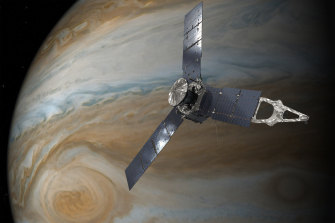What lies beneath the swirling gases of Jupiter, Saturn, Uranus and Neptune? A backyard astronomer in Perth may have just helped find the answer: a super-dense rocky planet, unlike anything seen before by astronomers, orbiting a far-off star.
It is so dense it should be covered in gas, like Jupiter. But it’s not.

An artist's illustration of the 'core' orbiting close to its sun.Credit:University of Warwick / Mark Garlick / Supplied
Astronomers think it’s the left-over core from a destroyed gas giant. That, or current textbook theories of how gas giants form are not quite right.
“Finding it was a surprise – we found something that is so dense that it leaves us wondering ‘how could this have originated?’” said Thiam-Guan Tan, the backyard astronomer who helped spot the exoplanet.
His finding, as part of an international team of astronomers, was published in Nature on Thursday.
Known as TOI-849b, the exoplanet was first observed by NASA’s TESS space telescope.

Mr Tan's discovery has raised questions about the origin of giant planets such as Jupiter.Credit:NASA/JPL-Caltech
TESS looks at the whole sky; studying single exoplanets is left to Earth-bound observers.
And over the past decade, Mr Tan has established his backyard observatory as one of the key global sites where that work is done. He now works regularly with university astronomers around the world.
Mr Tan is an engineer with a keen interest in astronomy. In 2010 he bought a 30-centimetre telescope connected to a camera, set it up in his Mount Claremont backyard, and started hunting exoplanets.
A 30-centimetre telescope should not be able to image exoplanets hundreds of light years away in such detail. Mr Tan put his results down to his telescope technique and the custom software he wrote to “eke the signal out of the data I get”.
“Professionals, they sometimes express surprise that such work could be done by such a small telescope.”
And what Mr Tan’s telescope saw was an exoplanet like no other.
Astronomers think most planets form gradually, as gravity pulls rock and ice together into bigger and bigger clumps.
If a rocky planet gets to a certain mass – perhaps 10 times the mass of the Earth – it starts to exert such an enormous gravitational pull that ice and gas should be sucked to its surface, turning it into a gas giant.
But this model of gas giant-formation is not well-liked by astronomers.
“If I’m being honest about it, I don’t think we have a really good idea how they form,” said Monash University astronomer Professor Daniel Price. “To the point where Jupiter, it’s still not clear whether it has a core or not.”
The new planet, 849b is almost 40 times more massive than Earth. It should be a gas giant. But it's not.
“This is a planet half the size of the gas-giant Saturn, but with the same bulk density of the rock planet Earth.” said University of NSW astronomer Professor Chris Tinney. “Our theories don’t predict such things.”
How did 849b end up naked when it should be clothed?
The Nature paper advances a few theories.
One, it could have smacked violently into another planet, losing hold of its gas on the way.
Or it may orbit so close to its star the star’s gravity and solar wind has stripped its gas. TOI-849b orbits its parent star once every 18 hours, hanging close enough to its sun that its surface is red-hot.
Or – option three – it may suggest current theories about how gas giants form are wrong.
“In the end, my conclusion would be that planet formation is way more complicated, and produces way more types of planets, than even planetary theorists can imagine,” said Professor Tinney.
Liam is The Age and Sydney Morning Herald's science reporter
Most Viewed in National
https://www.smh.com.au/national/a-bizarre-super-dense-planet-raises-questions-about-gas-giants-20200701-p557w6.html
2020-07-03 01:43:45Z
CAIiEGpucfoyYj-9SI47sHvCSa0qGQgEKhAIACoHCAowxqmICzDg_IYDMIGkmwY
Bagikan Berita Ini















0 Response to "A bizarre, super-dense planet raises questions about gas giants - Sydney Morning Herald"
Post a Comment